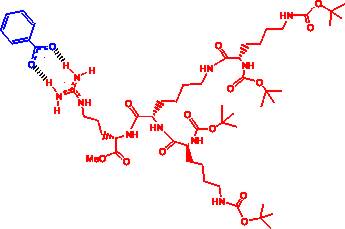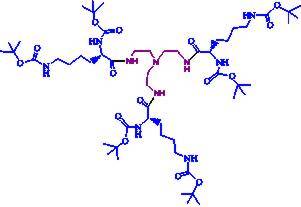Kevin Partridge

Kevin Partridge |
 |
PhD: Dendritic Peptides as Anion ReceptorsMChem: Supramolecular Dendritic Gels |
The binding of anionic guests is a challenge that has been of interest for many years. Although much more is known about the binding and recognition of cations, anions are an extremely important class of molecules. 70% of enzyme substrates are anionic, anions can alter the properties of compounds in solution and have been found to be major pollutants. One of the greatest challenges in anion binding is the diversity of shape and size of anions found in Nature, combined with their extremely hydrophilic nature.
In this work, two anion binding moieties, the guanidinium group and the tris (2-aminoethyl) amine (tren) group, have been attached to an already well characterised poly-lysine dendritic branch to form selective hosts for the binding of anionic species. The guanidinium group is a preorganised hydrogen-bonding site for the recognition of carboxylate or phosphate anions, found in nature in the amino acid arginine. Whereas the tren group is well known in the literature for it’s molecular recognition properties. The dendritic branch should provide encapsulation of the hydrophilic anion within its poly-amide interior, providing the whole complex with solubility in organic solvents.
Both hosts have been synthesised up to the second generation (see Figures 1 and 2) and the anion binding properties are being investigated using UV and NMR titrations with a variety of anions. The arginine based receptors show great potential for the binding of a variety of anions as visualised by NMR titrations. In contrast the tren receptors show less effective anion binding, but current results suggest they can bind sulfonates with limited chiral selectivity.
 |
 |
2nd Generation Arginine Receptor Binding a Benzoate
Anion |
First Generation Tren Host |
Both of these receptor molecules show potential for development into really useful sensors or transport agents. The arginine receptors are an important step towards phosphate extractants and the tren based receptors could be of great interest to the dyeing industry, which uses a great many sulfonates and sulfonic acids.